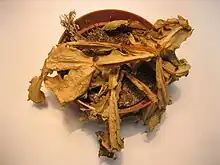Permanent wilting point
Permanent wilting point (PWP) or wilting point (WP) is defined as the minimum amount of water in the soil that the plant requires not to wilt. If the soil water content decreases to this or any lower point a plant wilts and can no longer recover its turgidity when placed in a saturated atmosphere for 12 hours. The physical definition of the wilting point, symbolically expressed as θpwp or θwp, is said by convention as the water content at −1,500 kPa (−15 bar) of suction pressure, or negative hydraulic head.[1]

History
The concept was introduced in the early 1910s. Lyman Briggs and Homer LeRoy Shantz (1912) proposed the wilting coefficient, which is defined as the percentage water content of a soil when the plants growing in that soil are first reduced to a wilted condition from which they cannot recover in approximately saturated atmosphere without the addition of water to the soil.[2][3] See pedotransfer function for wilting coefficient by Briggs.
Frank Veihmeyer and Arthur Hendrickson from University of California-Davis found that it is a constant (characteristic) of the soil and is independent of environmental conditions. Lorenzo A. Richards proposed it is taken as the soil water content when the soil is under a pressure of −15 bar.[4]
See also
References
- Weil, Ray R.; Brady, Nyle C. (2016). The Nature and Properties of Soils (15th ed.). Columbus, Ohio: Pearson. p. 221. ISBN 9780133254488. LCCN 2016008568. OCLC 936004363.
- Briggs, Lyman J.; Shantz, H. L. (1912). "The wilting coefficient and its indirect determination". Botanical Gazette. 53 (1): 20–37. doi:10.1086/330708. JSTOR 2467365.
- Taiz, Lincoln; Zeiger, Eduardo (1991). Plant Physiology. Redwood City, California: Benjamin Cummings. ISBN 080530245X. OCLC 757209580.
- Veihmeyer, F.J. & Hendrickson, A.H. (1928). "Soil moisture at permanent wilting of plants". Plant Physiol. 3 (3): 355–357. doi:10.1104/pp.3.3.355. PMC 440017. PMID 16652577.